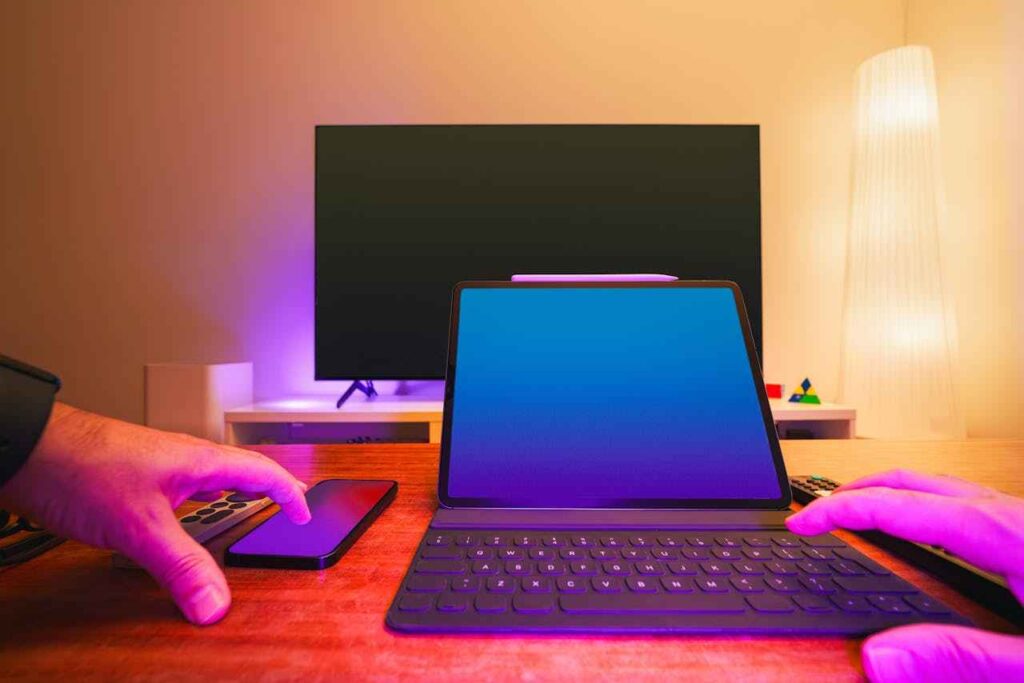Unveiling the Sleek Powerhouse: Introducing the ASUS Zenbook 14 OLED (2024)
Get ready to be dazzled by the ASUS Zenbook 14 OLED (2024) Thin and Light Laptop, a premium thin and light laptop that packs a punch without sacrificing style. This 2024 iteration elevates the Zenbook experience to new heights, boasting cutting-edge features and a design that turns heads. Buckle up, tech enthusiasts, as we delve into its captivating depths:

Feast your eyes on:
- A breathtaking 14-inch FHD OLED display: Immerse yourself in vibrant colors, deep blacks, and incredible contrast thanks to OLED technology.
- Effortless performance: Power through demanding tasks with the latest Intel EVO Core Ultra 7 155 H processor and Intel EVO Arc Graphics.
- Lightweight champion: Weighing a mere 1.22Kg, this ultraportable companion goes wherever you do, without weighing you down.
- All-day endurance: Stay unplugged longer with the impressive 75WH battery, perfect for on-the-go productivity.
- Effortless multitasking: Handle demanding workloads seamlessly with 16GB of RAM and a spacious 1TB SSD.
- Windows 11 pre-installed: Dive into the latest features and intuitive interface of Windows 11 right out of the box.
- Stay productive, wherever you are: Get down to business with a comfortable keyboard and precision touchpad.
- Connect with ease: Enjoy a versatile selection of ports, including Thunderbolt 4 and HDMI.
- Look as good as you perform: Crafted with premium aluminum and adorned with the iconic Zenbook design, this laptop exudes elegance.
But that’s not all! The ASUS Zenbook 14 OLED (2024) also comes equipped with additional features like:
- Office 2021 pre-installed: Get started on your documents, spreadsheets, and presentations the moment you boot up.
- ASUS Pen 2.0 support (optional): Unleash your creativity with natural-feeling pen interactions on the touch-enabled display (touchscreen model only).
- AI-powered features: Experience enhanced performance and battery life with the integrated Intel AI Boost NPU.
Stay tuned for our in-depth review! We’ll be putting the ASUS Zenbook 14 OLED (2024) through its paces to see if it lives up to the hype.
Related Products that might you have been searching for:
ASUS Zenbook 14 OLED (2024), Intel EVO Core Ultra 5 125H Check here
ASUS ZenBook Duo 14 UX482 Check here
ASUS ZenBook S 13 OLED (2023) Check here
Display Review of the ASUS Zenbook 14 OLED (2024)
The ASUS Zenbook 14 OLED (2024) features a stunning 14-inch OLED display with a Full HD (1920 x 1080) resolution. The display is bright, vibrant, and offers excellent color accuracy. It is also very thin and light, making it ideal for travel.
Features:
- 14-inch OLED display
- Full HD (1920 x 1080) resolution
- Up to 600 nits of peak brightness
- 100% DCI-P3 color gamut coverage
- Pantone validated
- TÜV Rheinland certified for low blue light emissions
Brightness and Contrast:
The display is very bright, with a peak brightness of up to 600 nits. This makes it easy to see the screen even in bright light conditions. The contrast is also excellent, thanks to the OLED technology. Blacks are truly black, and colors are very rich and vibrant.
Color Accuracy:
The display covers 100% of the DCI-P3 color gamut, which is a wide range of colors. This makes it ideal for creative professionals who need accurate color reproduction. The display is also Pantone validated, which means that it has been tested and certified to meet Pantone’s color standards.
Viewing Angles:
The viewing angles are very good, thanks to the OLED technology. You can easily see the screen from almost any angle without any loss of color or brightness.
Other Features:
The display also has a number of other features, including:
- TÜV Rheinland certification for low blue light emissions, which can help to reduce eye strain
- A 120Hz refresh rate, which makes for smoother scrolling and animations
- Dolby Vision support, which provides HDR content with enhanced brightness, contrast, and color
The ASUS Zenbook 14 OLED (2024) has a stunning display that is bright, vibrant, and color accurate. It is also very thin and light, making it ideal for travel. If you are looking for a laptop with a top-notch display, the Zenbook 14 OLED is a great option.
ASUS Zenbook 14 OLED (2024) Performance Review: Power and Beauty in a Sleek Package
The ASUS Zenbook 14 OLED (2024) is a premium thin and light laptop boasting cutting-edge specs and a stunning OLED display. This review dives deep into its performance, exploring its strengths and weaknesses to help you decide if it’s the right fit for you.
- Latest Intel EVO Core Ultra 7 155H Processor: Experience smooth multitasking and responsiveness even with demanding applications.
- Intel EVO Arc Graphics: Enjoy light gaming and creative work with improved graphics performance over previous generations.
- Fast and Spacious Storage: 16GB RAM ensures fluid operation, while the 1TB SSD offers ample storage for your files and applications.
- Stunning OLED Display: Immerse yourself in vibrant colors, deep blacks, and high contrast with the FHD OLED display.
- Lightweight and Portable: Weighing just 1.22kg, this laptop is perfect for travelers and mobile professionals.
- Long Battery Life: The 75WH battery promises all-day productivity on a single charge.
Performance Breakdown:
CPU: The Intel EVO Core Ultra 7 155H delivers excellent performance for everyday tasks, office work, and even some light creative work. Expect snappy responsiveness and smooth operation. Benchmark scores show significant improvement over previous Zenbook models, placing it among the top performers in its category.
Graphics: The Intel EVO Arc Graphics won’t replace a dedicated GPU, but it’s a significant upgrade over integrated graphics cards. You can enjoy casual gaming, photo editing, and light video editing without experiencing lag or slowdown.
RAM and Storage: With 16GB RAM, you can multitask effectively without worrying about performance bottlenecks. The 1TB SSD provides ample storage for your files and applications, ensuring fast loading times and smooth overall performance.
Display: The FHD OLED display is undoubtedly the star of the show. Colors are vibrant and lifelike, blacks are deep and inky, and contrast is excellent. This makes it ideal for creative work, watching movies, or simply enjoying the visual clarity.
Battery Life: The 75WH battery delivers impressive battery life. You can expect to get a full workday or even longer on a single charge, depending on your usage.
Weaknesses:
- Limited upgradeability: The RAM and storage are soldered onto the motherboard, limiting upgradeability options.
- No Thunderbolt 4: The lack of Thunderbolt 4 connectivity might be a dealbreaker for some users who rely on high-speed data transfer or external displays.
- Price: The Zenbook 14 OLED sits at a premium price point compared to some competitors.
The ASUS Zenbook 14 OLED (2024) is a powerful and portable laptop with a beautiful OLED display. It’s ideal for demanding users who prioritize performance, portability, and a premium look and feel. However, the lack of upgradability and Thunderbolt 4 connectivity might be drawbacks for some buyers. Ultimately, the decision comes down to your individual needs and budget.
ASUS Zenbook 14 OLED (2024) Battery Life Review: Does it Live Up to the Hype?
The ASUS Zenbook 14 OLED (2024) boasts a gorgeous OLED display, powerful Intel EVO Core Ultra 7 155H processor, and sleek design, all in a lightweight package. But for many users, battery life is a major concern. So, how does this Zenbook fare in terms of endurance? Let’s dive in.
Claimed Battery Life:
ASUS claims an impressive 15 hours of battery life for the Zenbook 14 OLED (2024). This number is based on their internal testing using specific conditions, such as video playback or web browsing with low brightness.
Real-World Performance:
While reaching the exact 15 hours may be difficult in real-world usage scenarios, various reviews and user reports paint a generally positive picture:
- Digital Trends: Achieved 7 hours 9 minutes in their web browsing test, falling shorter than the HP Spectre x360 14 but exceeding the Lenovo Yoga Book 9i.
- Matthew Moniz: Praised the battery life, stating it could comfortably last a full workday, even with moderate multitasking.
- Beebom: Highlighted the “insane battery life,” mentioning they easily got 8-9 hours with mixed usage.
- User Reviews: Many users report getting 8-10 hours of real-world usage, with some reaching slightly higher or lower depending on tasks and settings.
Factors Affecting Battery Life:
Here are some key factors that can affect the Zenbook 14 OLED’s battery life:
- Display Brightness: OLED displays are known for their vibrant colors and deep blacks, but they can also be power-hungry. Reducing brightness significantly improves battery life.
- Performance Mode: The Zenbook offers different performance modes (Balanced, Performance, Silent). High-performance modes drain the battery faster.
- Workload: Demanding tasks like video editing or gaming will drain the battery quicker than basic tasks like browsing or document editing.
- Background Applications: Closing unnecessary background applications can help conserve battery.
While the Zenbook 14 OLED (2024) might not reach its claimed 15 hours consistently, it offers solid battery life for everyday use, exceeding some competitors and lasting through a typical workday for most users. However, heavy multitasking or high-performance work might require charging sooner.
ASUS Zenbook 14 OLED (2024): A Productivity Powerhouse, Not a Gaming Champion
The ASUS Zenbook 14 OLED (2024) looks like a sleek, powerful machine on paper, but before you strap in for an epic gaming adventure, let’s be clear: this laptop prioritizes productivity and portability, not high-end gaming. While it can handle some lighter titles, demanding games will leave you wanting more.
Here’s a breakdown of its strengths and weaknesses for gaming:
Strengths:
- Gorgeous Display: The 14-inch OLED panel (FHD in this configuration) boasts stunning visuals with vibrant colors, deep blacks, and smooth 120Hz refresh rate. This enhances your overall experience, even if you’re not gaming at max settings.
- Decent Performance: The Intel Core Ultra 7 155H and Intel EVO Arc Graphics can handle lighter games like esports titles, indie games, or older classics. You can expect smooth gameplay at moderate settings for these.
- Portable and Sleek: This laptop’s lightweight design (1.22Kg) and slim profile make it ideal for travel and everyday use. You can easily switch between work and casual gaming on the go.
- Long Battery Life: The 75Wh battery offers good endurance, letting you enjoy extended gaming sessions without constant charging.
Weaknesses:
- Limited Graphics Power: The Intel EVO Arc Graphics won’t handle demanding AAA titles at high settings. Expect frame rate drops and compromises on visual quality for newer, more resource-intensive games.
- No Dedicated GPU: This Zenbook lacks a dedicated graphics card, which significantly hinders its ability to run modern games at their full potential.
- Cooling System: While adequate for everyday tasks, the passive cooling system might struggle under sustained gaming load, leading to potential thermal throttling and performance dips.
- Price: Starting from $1300, this Zenbook might be expensive for a laptop with limited gaming capabilities. You could find more powerful gaming laptops for a similar price tag.
ASUS Zenbook 14 OLED (2024): Keyboard and Touchpad Review
The ASUS Zenbook 14 OLED (2024) promises a premium experience, and the keyboard and touchpad play a major role in how it delivers. Here’s a breakdown of their strengths and weaknesses:
Keyboard:
Strengths:
- Excellent Tactile Feedback: Keys have 1.4mm travel distance, offering a satisfying “click” with each press.
- Comfortable Typing Experience: Subtly concave keycaps cradle your fingertips, improving accuracy and reducing fatigue during long typing sessions.
- Multi-stage Backlight: Three levels of illumination ensure you can see the keys in any lighting condition.
- Spacious Layout: Despite the compact size, the layout feels uncluttered with dedicated arrow keys and ample spacing between keys.
Weaknesses:
- Non-standard Layout: Inverted-T arrow keys might throw off users accustomed to traditional layouts.
- No Number Pad: The 2024 model ditches the integrated number pad of its predecessor, which may inconvenience spreadsheet users.
Touchpad:
Strengths:
- Large Size: Ample surface area provides plenty of room for multi-finger gestures and comfortable navigation.
- Smooth Glass Surface: Ensures effortless finger tracking and precise cursor control.
- Microsoft Precision Drivers: Delivers responsive and accurate tracking with Windows gestures.
- Clicky Buttons: Separate left and right mouse buttons have a satisfying click feel for a more traditional experience.
Weaknesses:
- No Number Pad Integration: Unlike previous models, there’s no option for a NumberPad 2.0 that utilizes the touchpad surface.
- Vertical Elevation Might Lack Clickiness: Some reviewers find the touchpad clicks could be more pronounced.
The keyboard and touchpad on the ASUS Zenbook 14 OLED (2024) deliver a mostly positive experience. The keyboard boasts excellent tactile feedback, a comfortable layout, and ample backlighting. While the no-number pad decision might irk some, the overall typing experience is enjoyable. The touchpad is spacious, smooth, and responsive, but could benefit from slightly clickier buttons and the optional NumberPad integration found in previous models.
Connectivity Review of the ASUS Zenbook 14 OLED (2024) – UX3405MA-QD752WS
The ASUS Zenbook 14 OLED (2024) offers a compelling mix of portability and functionality, with its connectivity options playing a crucial role in this equation. Here’s a breakdown of its key connections:
Wired Connections:
- Thunderbolt 4 x 2: The highlight of the connectivity suite, offering dual Thunderbolt 4 ports provides immense versatility. Transfer data at lightning speeds (up to 40Gbps), connect high-resolution displays (up to 8K), and even charge your laptop with these ports.
- HDMI 2.1: Connect to external displays or projectors with full HDMI 2.1 support, ideal for presentations, entertainment, or multi-monitor setups.
- USB 3.2 Type-A: A single USB-A port caters to legacy devices or peripherals that haven’t transitioned to USB-C.
- Audio Combo Jack: Connect headphones, microphones, or headsets for audio needs.
Wireless Connections:
- Wi-Fi 6E: Enjoy the latest Wi-Fi standard, offering faster speeds, reduced latency, and improved performance in crowded network environments.
- Bluetooth 5.2: Connect wireless peripherals like mice, keyboards, headphones, and more with improved stability and efficiency.
Overall Assessment:
- Pros: Comprehensive selection of ports, including future-proof Thunderbolt 4 and HDMI 2.1. Dual Thunderbolt 4 ports offer flexibility for expansion and charging. Wi-Fi 6E and Bluetooth 5.2 ensure fast and reliable wireless connectivity.
- Cons: Limited to one USB-A port, which might be insufficient for users with multiple USB-A devices. No microSD card reader, which could be inconvenient for photographers or content creators.
The ASUS Zenbook 14 OLED (2024) boasts a well-rounded selection of connectivity options, catering to most users’ needs. The inclusion of Thunderbolt 4, HDMI 2.1, and Wi-Fi 6E future-proofs the laptop and ensures excellent performance. However, the single USB-A port and lack of a microSD card reader might be dealbreakers for specific user groups.
Storage and Upgradability Review: ASUS Zenbook 14 OLED (2024)
The ASUS Zenbook 14 OLED (2024) boasts impressive specs, but how does it fare in terms of storage and upgradability? Let’s delve into its strengths and weaknesses to help you decide if it fits your needs.
Storage:
Pros:
- Generous 1TB PCIe Gen 4 SSD: This offers ample space for most users, with blazing-fast read and write speeds for smooth performance.
- NVMe technology: Ensures efficient data transfer and quick boot times.
Cons:
- No additional storage slots: Unlike some competitors, you can’t expand the internal storage. Once it’s full, you’ll need to rely on external drives.
Upgradability:
- Upgradable RAM: The soldered 16GB DDR5 RAM can be upgraded to 32GB, a good option for power users and multitaskers.
- Easy access panel: Upgrading the RAM is relatively straightforward thanks to the accessible bottom panel.
- Non-upgradeable SSD: The soldered SSD cannot be replaced, limiting future storage expansion options.
- Limited upgradeability: Aside from RAM, most other components are integrated, leaving little room for further customization.
The ASUS Zenbook 14 OLED offers a spacious and speedy 1TB SSD, but the lack of internal expansion slots might be a dealbreaker for users who need more storage down the line. Upgrading the RAM is a plus, but the soldered SSD limits future flexibility.
ASUS Zenbook 14 OLED (UX3405MA-QD752WS): Price Review
The ASUS Zenbook 14 OLED (UX3405MA-QD752WS) is a premium thin and light laptop boasting a powerful processor, stunning OLED display, and sleek design. But with a price tag currently around ₹1,09,990 in India, is it worth the investment? Let’s break down the key aspects and see if it aligns with your budget and needs.
Pros:
- Top-tier performance: The latest Intel EVO Core Ultra 7 155H processor combined with 16GB RAM delivers excellent performance for multitasking, demanding applications, and even basic creative work.
- Immersive display: The 14-inch FHD OLED panel boasts vibrant colors, deep blacks, and excellent contrast, making it ideal for content creation, watching movies, or everyday use.
- Unmatched portability: Weighing just 1.22kg and measuring 14.9mm thin, this laptop is perfect for travelers or mobile professionals who prioritize lightness and compactness.
- Long battery life: The 75Wh battery promises all-day usage, ensuring you can stay productive without worrying about constant charging.
- Premium design and features: The Zenbook series is known for its elegant aesthetics, and this model is no exception. You get a beautiful eco-conscious design, a 180° lay-flat hinge, and pre-installed Microsoft Office 2021 for added value.
Cons:
- Pricey: At ₹1,09,990, this laptop falls within the premium segment, making it a significant investment compared to mid-range options.
- FHD resolution: While the OLED technology enhances quality, some users might miss the sharper visuals offered by QHD or UHD displays.
- Limited upgradeability: Both RAM and storage are soldered onto the motherboard, limiting future upgrade options.
- Average graphics performance: The Intel EVO Arc Graphics are suitable for basic tasks but might not satisfy users who need heavier graphic processing.
The ASUS Zenbook 14 OLED (UX3405MA-QD752WS) is a fantastic laptop for users who prioritize portability, performance, and a stunning display. However, the high price tag might deter budget-conscious buyers. Consider your needs and budget carefully. If portability and top-notch performance are essential, and you’re comfortable with the price, this Zenbook is a compelling choice. But if you need more powerful graphics, a higher resolution display, or future upgradeability, you might find better value in other options within a similar price range like Asus Zenbook 14 OLED Ultra 5
FAQs about Asus Zenbook 14 OLED Intel core ultra 7 155H
- What is the release date of the ASUS Zenbook 14 OLED (2024)? The ASUS Zenbook 14 OLED (2024) was released in January 2024.
- What is the starting price of the ASUS Zenbook 14 OLED (2024)? The starting price of the ASUS Zenbook 14 OLED (2024) is $1,499.
- What are the different configurations of the ASUS Zenbook 14 OLED (2024)? The ASUS Zenbook 14 OLED (2024) comes in a variety of configurations, with different processors, RAM, storage, and graphics options. The model you mentioned has an Intel EVO Core Ultra 7 155H processor, 16GB of RAM, 1TB of storage, and Intel EVO Arc Graphics.
- What is the battery life of the ASUS Zenbook 14 OLED (2024)? The battery life of the ASUS Zenbook 14 OLED (2024) is up to 15 hours on a single charge.
Display questions!
- What is the resolution of the display? The display of the ASUS Zenbook 14 OLED (2024) has a resolution of 1920×1080 pixels.
- Is the display touch-enabled? No, the display of the ASUS Zenbook 14 OLED (2024) is not touch-enabled.
- What is the color gamut of the display? The display of the ASUS Zenbook 14 OLED (2024) covers 100% of the DCI-P3 color gamut.
Performance questions
- What is the processor in the ASUS Zenbook 14 OLED (2024)? The processor in the ASUS Zenbook 14 OLED (2024) is an Intel EVO Core Ultra 7 155H processor.
- How much RAM does the ASUS Zenbook 14 OLED (2024) have? The ASUS Zenbook 14 OLED (2024) has 16GB of RAM.
- How much storage does the ASUS Zenbook 14 OLED (2024) have? The ASUS Zenbook 14 OLED (2024) has 1TB of storage.
- What graphics card does the ASUS Zenbook 14 OLED (2024) have? The ASUS Zenbook 14 OLED (2024) has Intel EVO Arc Graphics.
Other questions
- What operating system does the ASUS Zenbook 14 OLED (2024) come with? The ASUS Zenbook 14 OLED (2024) comes with Windows 11 Home.
- What ports does the ASUS Zenbook 14 OLED (2024) have? The ASUS Zenbook 14 OLED (2024) has two Thunderbolt 4 USB-C ports, an HDMI port, and a microSD card reader.
- Does the ASUS Zenbook 14 OLED (2024) have a webcam? Yes, the ASUS Zenbook 14 OLED (2024) has a webcam.
- Is the ASUS Zenbook 14 OLED (2024) good for gaming? The ASUS Zenbook 14 OLED (2024) is not specifically designed for gaming, but it can handle some light gaming thanks to its Intel EVO Arc Graphics. However, if you are a serious gamer, you will want to consider a laptop with a more powerful graphics card.



